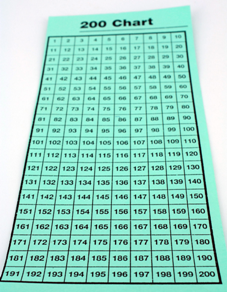Diagnostic questions
Explain that estimating means to use a simple calculation to get a rough idea of an answer. Tell the student that you are going to give them some problems. Their job is to estimate the answer to each problem.
- Show the student collections of counters. Ask the student to show you an easy way to work out roughly how many counters there are in each pile.
a. 24 counters b. about 50 counters c. about 100 counters. - Jackson eats two bananas every morning. How many bananas would he eat in a year? (Provide the student with a calendar to help them make an estimate.)
- Six friends win $1,000 in a raffle. They want to share the money evenly. About how much money should each person get? (Provide the student with 10 x $100 paper money notes.)
What to notice in the student’s response
Does the student:
- avoid the question by saying “I don’t know”?
- give a random response with little or no evidence of reasoning?
- try to find an exact answer?
- come up with a sensible estimate?
 Deliberate acts of teaching
Deliberate acts of teaching
Materials/Links
- Paper clips
- Counters
- 200 Chart
Estimation and approximation strategies rely on a good sense of the number system. Knowing how to estimate allows students to check whether their answers to mathematical problems are likely to be correct.
Estimating an amount
One way to estimate an amount is to compare a known quantity to an unknown quantity.
Show the students a chain made of 10 paper clips and a longer chain of about 32 paper clips. Discuss with student how you could use the small chain to estimate the number of paper clips in the long chain.
Ask the student to estimate how long a chain of 100 paper clips would be and get them to explain their reasoning.
Estimating an answer
Give the student a problem involving multiplying. For example, 4 children each have 23 toys. Approximately how many toys are there altogether? If the student finds it difficult to estimate the answer, give them a 200 chart. Tell the student to work from 1 and to cross out lines of numbers that they are certain are not the answer. Once they are no longer certain, get them to work backwards from 200, crossing out lines of numbers that they think are too large. Ask the student to explain how they made their decisions.
Discuss with the student how many groups of ten there are in 23. Show them how they can use this to make an estimate (4 x 2 tens = 8 tens = 80).
The “unit” does not have to be a group of 10. For example, if you have 50 lollies to share between 8 people, you can break the 50 into ten groups of 5. Each person gets one group of 5 and there will be a few lollies left over. Some students may recognise that the remaining 2 groups of 5 can be separated into 10 ones, which can then be shared out among the 8 people (with 2 left over). If the student doesn’t make this connection, don’t point it out. Keep the emphasis on using groups to find an approximate answer.
What to do next if the student is stuck
Continue working with materials. Make links between using a unit to estimate an amount and using groups of 10 to estimate the answer to a problem.
Initiating home-based activities
Encourage parents to discuss how and when they need to estimate a value, for example, at the grocery store or when cooking.
Next teaching steps back in the classroom
Model the use of estimation when introducing a new problem. Ask the student what size they expect an answer to be. Ask a range of students to volunteer the method they used to make their estimate.
Using a specific task, explain the process you would use to estimate the answer and ask the student to repeat it back to you.